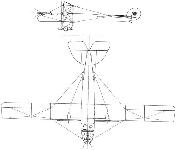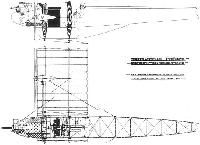C.Andrews Vickers Aircraft since 1908 (Putnam)
<...>
A side issue of some interest to the Gunbus story was the request from the German Government, made early in 1914, for details of Vickers fighting biplanes. Apparently there was nothing sinister in this approach, which was similar to that made to the Sopwith and other British aircraft companies; Britain was never seriously regarded as a potential enemy by Germany even at that late date, and its interest was doubtless genuine.
In offering the Type 18 series to the Germans, Vickers said, 'What we have at the present moment is a type of machine which is not existent in the German Army, in fact not in Europe except in England. This machine is intended for offensive action in the air against other planes and dirigibles, consequently it is not equipped with a bomb-dropping apparatus. The light Maxim gun mounted in the nose is so placed as to enable the gunner to have a free field of fire against other aeroplanes. We can carry Pilot, Observer, Barograph, Gun, 300 rounds of ammunition, and fuel for 4 hours. Loaded with this, it can easily attain a height of 800 metres in 15 minutes. The speed of the machine is 105 km/hr instead of 90 required by the German Authorities. We can reduce to 70 km/hr if required.'
This design was not accepted, but in response to a further request from the German Government, three advanced designs for aircraft, called G.F.B.1, G.F.B.2 and G.F.B.3 (German Fighting Biplanes), which resembled in many respects the Hydravion projects, were prepared during the early months of 1914. Details of only the last two are now available; these were alike, except that the G.F.B.2 had two 100 hp Gnome monosoupape engines while the G.F.B.3 had two 140/165 hp Austro-Daimlers. The engines were mounted side by side in the fuselage, driving two tractor propellers, and clutches could cut out one or both.
These large three-seat biplane designs had provision for a 37-mm one-pounder gun mounted in the nose, and the pilot and observer were seated in the fuselage behind the engines. Specified equipment included wireless and 50 rounds of ammunition. The upper wings were of greater span than the lower, and for hangarage purposes the outer sections of the upper wings could be lowered, thus reducing the span from 72 to 59 ft. The G.F.B.3 was designed for a maximum speed of 72 mph with an endurance of five hours, and the all-up weight was estimated at 4,000 lb. The outbreak of war in August 1914 prevented construction of these interesting designs.
M.Goodall, A.Tagg British Aircraft before the Great War (Schiffer)
Deleted by request of (c)Schiffer Publishing
VICKERS German Fighting biplanes GFB.1/3
Three advanced designs for fighting biplanes were prepared for the German Government in early 1914. Known as the GFB. 1, GFB.2 and GFB.3 they had some features in common with the Types 14 and 14B Hydravions, but had a conventional fuselage. The engine or engines were installed inside the fuselage driving two tractor airscrews, mounted outboard on the wing interplane struts, through shafts and bevel gearing. Clutches could cut out one or both engines. The engine of the GFB1 was a 200hp Gnome. The GFB2 would have had two 100hp Gnome Monosoupape and the GFB3 two 140/165hp Austro-Daimler.
A crew of three would have been carried, with pilot and observer behind the engines and a gunner in the nose with a 37mm one-pounder cannon. Equipment specified included wireless and fifty rounds of ammunition.
It is possible that some work was carried out on one of the machines but was canceled at the outbreak of war in August 1914.
Data
Span (upper) 72ft (folded 59ft)
Gross weight 4000 lb
Max speed 72 mph
Endurance 5 hours



